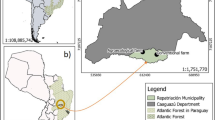Abstract
Populations of soil-dwelling mites were monitored in monoculture plots of four agroforestry tree species, Gliricidia sepium, Leucaena leucocephala, Dactyladenia barteri and Treculia africana, and compared to those in grass and secondary forest plots in the dry season (December 1993 to January 1994) and in the wet season (April to June 1994) in southwest Nigeria. Mite populations were very low in all plots during the dry season (500–3000 m–2), compared to those during the wet season (10 000–30 000 m–2). The highest mite population was observed in Gliricidia plots (3 044 m–2) for the dry season and Leucaena plots (30 240 m–2) for the wet season. Mite genera that were dominant in all the experimental plots were Annectacarus, Haplozetes, Machadobelba, Scheloribates and members of the Galumnidae, Dermanyssidae and Parasitidae. The community structure of mites was similar in the soil for Treculia and Gliricidia plots and for Leucaena and Dactyladenia plots. There were more taxonomic groups of mites under Leucaena than in the other agroforestry plots. Based on the density, diversity and complexity of the mite communities, Leucaena was considered to be better than other agroforestry species in encouraging the growth of mite populations.
Similar content being viewed by others
Author information
Authors and Affiliations
Additional information
Received: 28 April 1998
Rights and permissions
About this article
Cite this article
Badejo, M., Tian, G., Badejo, M. et al. Abundance of soil mites under four agroforestry tree species with contrasting litter quality. Biol Fertil Soils 30, 107–112 (1999). https://doi.org/10.1007/s003740050595
Issue Date:
DOI: https://doi.org/10.1007/s003740050595




